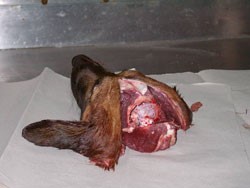
Animal Rabies diagnosis & Research laboratory
Animal Rabies diagnosis & Research laboratory
Clinical disease
Clinical signs in animals
The clinical features of rabies are
similar in most species,but there is great variation between individuals.
Following the bite of a rabid animals the incubation period is usually between
14 and 90 days, but may be considerably longer.
There are two clinical forms of the
disease are recognized : furious and dumb or paralytic.
In furious form
the animal becomes
restless,nervous,aggressive and often dangerous as it loses all fear of man and
bites at anything that gains its attention. The animal often cannot swallow
water,giving rise to the synonym for the disease, " hydrophobia. "
There is often excessive salivation,exaggerated responses to light and sound.
As the encephalitis progresses,fury gives way to paralysis and the animal
presents the same clinical features as seen in the dumb form of the disease.
Terminally, there are often
convulsive seizures,coma and respiratory arrest, with death occurring 2 to 7
days after the onset of the clinical signs
Clinical signs of rabies in the dogs :
Prodromal Phase ( 2-3 days )
This phase often passes unnoticed, but there may be signs of behavior change, fever,slow corneal and palpebral reflexes and chewing at the bite site.
Furious Phase ( 2-4 days )
The limbic system of the CNS is invaded, resulting in signs of erratic behavior such as restlessness, barking, aggression, attacks on in animate objects. Ataxia, disorientation may develop.
Paralytic Phase ( 2-4 days )
Progressive lower motor neuron paralysis develops, causing signs of paresis or paralysis of the limbs ( often affecting a bitten extremity first ) , laryngeal paralysis ( chang in bark, dyspnea ) , Pharyngeal paralysis ( drooling,dysphagia ), and masticatory paralysis ( dropped jaw ) . These are followed by depression,coma and death from respiratory paralysis.

Diagnosis
Clinical signs and symptoms can serve
only to raise suspicion of rabies. Confirmation requires demonstration of
antigen detection, virus isolation in vitro, virus identification using
monoclonal antibodies , molecular techniques either in mice or preferably in
cell culture, or, where these techniques are not available.
Brain and spinal cord are the tissues
of choice; salivary glands are sometimes used for virus isolation. The use of
molecular probes and polymerase chain reaction (PCR) is not recommended for the
routine diagnosis of rabies.
Collection of samples
Head and neck of a suspect animal should be sent to the laboratory. Where this is not possible, brain samples may be taken in the field.


Submission of samples
- Samples should be contained within two shock-proof water-tight containers
- Both the inner and outer containers should be disinfected on the outside after closure
- The whole package should be contained within an insulated box containing "cool-packs"
- Samples should be kept as cool as possible without freezing
- Full details of the origin of each sample must be provided, together with all relevant epidemiological information which might assist in diagnosis
